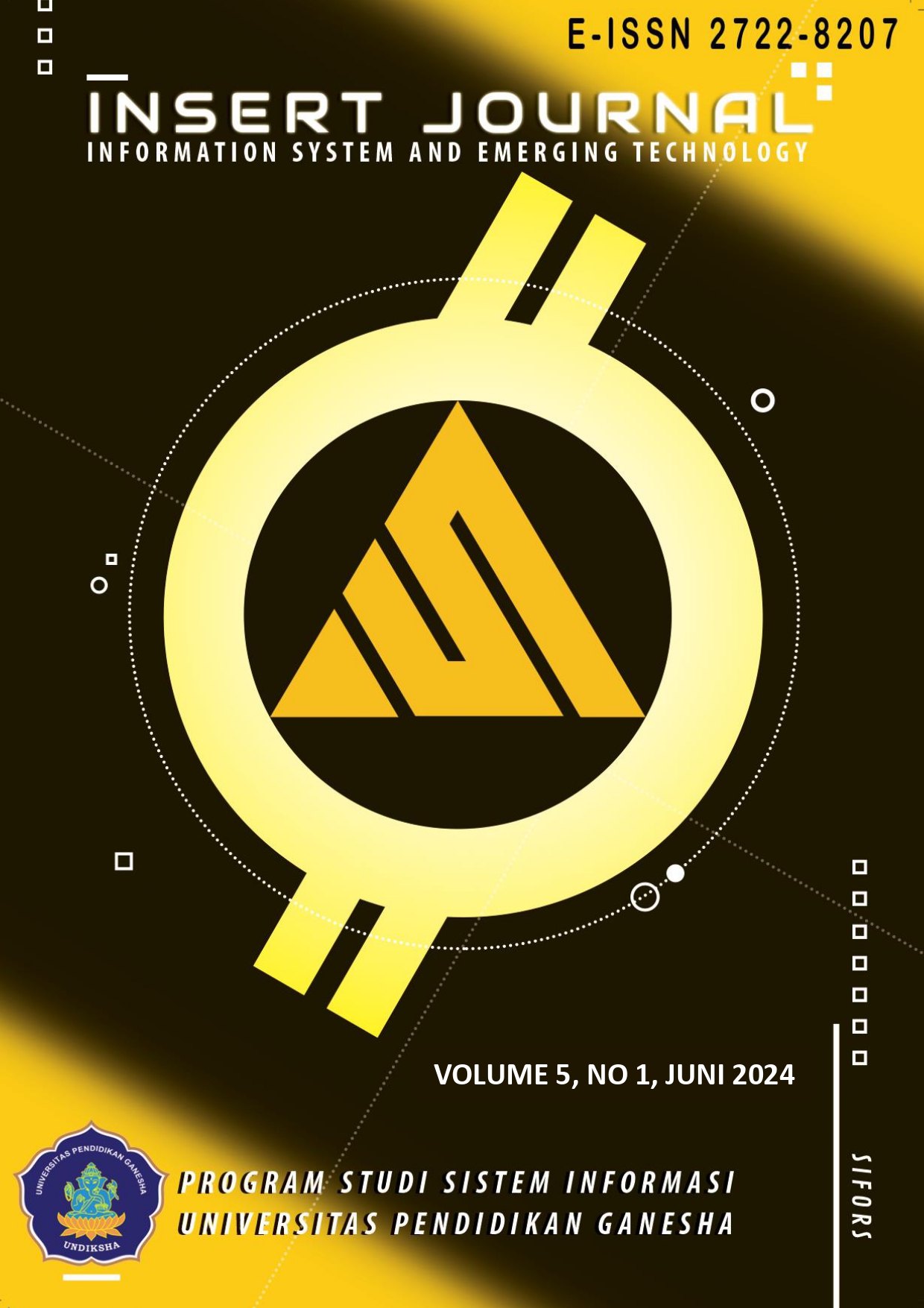Pengembangan Prototipe Sistem Informasi Skripsi Universitas Pendidikan Ganesha Menggunakan Metode User Centered Design
DOI:
https://doi.org/10.23887/insert.v5i1.68651Keywords:
Sistem Informasi Skripsi, UCD, ISO 9241-210, High-FidelityAbstract
Dampak pandemi Covid-19 pada sektor pendidikan telah mengubah lanskap pembelajaran secara signifikan, memaksa adaptasi dalam berbagai aspek, termasuk pelaksanaan skripsi yang harus menyesuaikan dengan pembelajaran daring. UPT TIK Undiksha merespons dengan merencanakan pembangunan sistem informasi skripsi. Namun, tantangan utama adalah ketiadaan pedoman terkait desain sistem yang berfokus pada pengguna, sehingga menghambat UPT TIK dalam merumuskan strategi tepat dalam membangun sistem yang sesuai dengan kebutuhan pengguna. Penelitian ini bertujuan untuk merancang antarmuka sistem informasi skripsi menggunakan metode User-Centered Design (UCD) berbasis ISO 9241-210. Sistem ini ditujukan bagi empat kelompok pengguna: mahasiswa, koordinator program studi, sekretaris jurusan, dan dosen, dengan kebutuhan fungsional yang spesifik. Melalui teknik PATHY dan fenomenografi, penelitian berhasil mengidentifikasi 20 kebutuhan pengguna penting. Solusi desain high-fidelity dikembangkan dengan memperhitungkan konteks penggunaan, kebutuhan pengguna, dan pedoman UI/UX, menggunakan perangkat Figma. Evaluasi dilakukan dengan metode System Usability Scale (SUS), dan hasilnya menunjukkan ketergunaan solusi desain dengan skor 73,5, mencerminkan keberhasilan dalam memenuhi harapan pengguna.
References
Alashqar, A. M., El-Bakry, H. M., & Elfetouh, A. A. (2015). Requirement Engineering for Non-Functional Requirements. International Journal of Information and Communication Technology Research , 5(2), 21–27. Retrieved from http://www.esjournals.org
Alshammari, T., Alhadreti, O., & Mayhew, P. J. (2015). When to Ask Participants to Think Aloud: A Comparative Study of Concurrent and Retrospective Think-Aloud Methods. International Journal of Human Computer Interaction (IJHCI), 6(2), 48–64.
Assarroudi, A., & Heydari, A. (2016). Phenomenography: A missed method in medical research. Acta Facultatis Medicae Naissensis, 33(3), 217–225. https://doi.org/10.1515/afmnai-2016-0023
Bangor, A., Kortum, P. T., & Miller, J. T. (2008). An empirical evaluation of the system usability scale. International Journal of Human-Computer Interaction, 24(6), 574–594. https://doi.org/10.1080/10447310802205776
Barnum, C. M. (2021). Preparing for Usability Testing. In Usability Testing Essentials (pp. 197–248). Elsevier. https://doi.org/10.1016/b978-0-12-816942-1.00006-x
Brooke, J. (2013). SUS: A Retrospective. Journal of Usability Studies (JUS), 8(2), 29–40.
Carroll, J. M., & Hertzum, M. (2020). Usability Testing A Practitioner’s Guide to Evaluating the User Experience. Copenhagen: Morgan and Claypool. https://doi.org/10.2200/S00987ED1V01Y202001HCI045
Dumas, J. S., & Redish, J. (1999). A Practical Guide to Usability Testing (Revised). Exeter: Intellect.
Erawati, N. W. E., Arthana, I. K. R., & Pradnyana, A. (2018). Usability Testing Dengan ISO/IEC 9126-4 Sistem Informasi Akademik Universitas Pendidikan Ganesha Ditinjau Dari Pengguna Dosen. Jurnal Pendidikan Teknologi Dan Kejuruan, 15(2), 287–298. Retrieved from https://ejournal.undiksha.ac.id/index.php/JPTK/issue/view/851
Falstad, A., Law, E. L. C., & Hornbæk, K. (2012). Outliers In Usability Testing: How To Treat Usability Problems Found for Only One Test Participant? NordiCHI 2012: Making Sense Through Design - Proceedings of the 7th Nordic Conference on Human-Computer Interaction, 257–260. https://doi.org/10.1145/2399016.2399056
Ferreira, B., Santos, G., & Conte, T. (2017). Identifying Possible Requirements Using Personas: A qualitative study. ICEIS 2017 - Proceedings of the 19th International Conference on Enterprise Information Systems, 2, 64–75. SciTePress. https://doi.org/10.5220/0006311600640075
Gulliksen, J., Göransson, B., Boivie, I., Blomkvist, S., Persson, J., & Cajander, Å. (2003). Key Principles for User- Centred Systems Design. Behaviour and Information Technology, 22(6), 397–409. https://doi.org/10.1080/01449290310001624329
ISO 9241-210. (2010). Ergonomics of Human-System Interaction - Part 210: Human-Centred Design for Interactive Systems. Switzerland.
Jokela, T., Iivari, N., Matero, J., & Karukka, M. (2003). The Standard of User-Centered Design and the Standard Definition of Usability: Analyzing ISO 13407 against ISO 9241-11. Proceedings of the Latin American Conference on Human-Computer Interaction, 53–60. https://doi.org/doi.org/10.1145/944519.944525
Kurniawan, M. A., Fitri, I., & Hidayatullah, D. (2021). Sistem Informasi Bimbingan Skripsi Menggunakan Metode Rapid Application Development Berbasis User Centered Design. Jurnal Media Informatika Budidarma, 5(3), 838. https://doi.org/10.30865/mib.v5i3.3068
Mao, J.-Y., Vredenburg, K., Smith, P. W., & Carey, T. (2005). The State of User-Centered Design Practice. Communications of the ACM, 48(3), 105–109. https://doi.org/doi.org/10.1145/1047671.1047677
Mendeley. (n.d.). Mendeley Reference Manager v2.12.0. Retrieved June 19, 2023, from Mendeley website: https://www.mendeley.com/release-notes-reference-manager/v2.12.0
Murman, D. L. (2015). The Impact of Age on Cognition. Seminars in Hearing, 36(3), 111–121. https://doi.org/10.1055/s-0035-1555115
Nielsen, J. (2000, March 18). Why You Only Need to Test with 5 Users. Retrieved March 3, 2022, from Nielsen Norman Group website: https://www.nngroup.com/articles/why-you-only-need-to-test-with-5- users/
Paramartha, A. A. G. Y., Darmawiguna, I. G. M., Kertiasih, N. K., & Khoerniawan, R. W. (2017). Sistem Informasi Pembimbingan Skripsi Online Berbasis Web (Studi Kasus: FTK, Undiksha). Seminar Nasional Vokasi Dan Teknologi (SEMNASVOKTEK), 56–64.
Ross, J. (2014). The Business Value of User Experience. Cranbury.
Sauro, J., & Lewis, J. R. (2016). Standardized Usability Questionnaires. In Quantifying the User Experience (pp. 185–248). Elsevier. https://doi.org/10.1016/b978-0-12-802308-2.00008-4
Sharfina, Z., & Santoso, H. B. (2016). An Indonesian Adaptation of the System Usability Scale (SUS). International Conference on Advanced Computer Science and Information Systems (ICACSIS), 145–148. Malang, Indonesia: Institute of Electrical and Electronics Engineers (IEEE).
Shneiderman, B., & Plaisant, C. (2005). Designing The User Interface : Strategies For Effective Human-Computer Interaction (4th ed.). College Park: Addison & Wesley.
Shofiyulloh, M. R., Wibowo, A. T., & Amin, F. M. (2020). Rancang Bangun Sistem Informasi Pelayanan Skripsi Untuk Mendukung Layanan Akademik. Nusantara Journal of Computers and Its Applications (NJCA), 5(1), 7–10. https://doi.org/10.36564/NJCA.V5I1.178
Sjöström, B., & Dahlgren, L. O. (2002). Applying phenomenography in nursing research. Journal of Advanced Nursing, 40(3), 339–345.
Tedeschi, B. (1999, August 30). Good Web Site Design Can Lead to Healthy Sales. The New York Times, pp. 1–1. Retrieved from https://archive.nytimes.com/www.nytimes.com/library/tech/99/08/cyber/commerce/30commer ce.html
UPT TIK. (2022, January 18). Rekap Keadaan Mahasiswa Semester Ganjil Tahun Akademik 2021/2022 Universitas Pendidikan Ganesha.
Usability.gov. (2022, March 13). Personas. Retrieved March 13, 2022, from Usability.gov website: https://www.usability.gov/how-to-and-tools/methods/personas.html
Utami, M., Apridiansyah, Y., & Putra, E. D. (2021). Perancangan E-Skripsi Universitas Muhammadiyah Bengkulu Menggunakan User Centered Design (UCD). Journal of Information Technology and Computer Science (INTECOMS), 4(1).
Zulfikar, F. (2022, October 27). Kisah Sam Maykel, Lulusan S2 Termuda ITB dengan Usia 21 Tahun. Retrieved June 19, 2023, from detikEdu website: https://www.detik.com/edu/edutainment/d - 6371878/kisah-sam-maykel-lulusan-s2-termuda-itb-dengan-usia-21-tahun
Downloads
Published
Issue
Section
License
Copyright (c) 2024 Kai Koga, I Made Ardwi Pradnyana, I Gede Mahendra Darmawiguna

This work is licensed under a Creative Commons Attribution-ShareAlike 4.0 International License.

INSERT is licensed under a Creative Commons Attribution-ShareAlike 4.0 International License.







